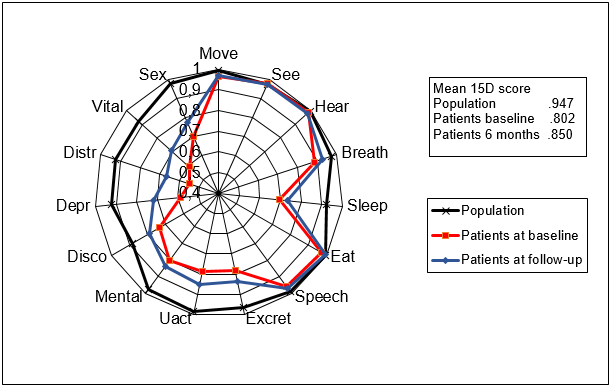Use as a profile instrument
When a person fills in the 15D questionnaire, the result is a 15-dimensional description of her/his health status. It shows the position of the person on the levels of each of the 15 dimensions of health. This is referred to as the 15D profile.
Similarly, a 15D profile for a group of persons (patients, population) can be constructed from the average position of the group on the levels of each of the 15 dimensions. It is recommended that the profiles are constructed on a 0-1 scale by using the variables, where the original ordinal numbers of the levels (1-5) have been replaced by level values produced by the valuation system.
Graphically the profiles can be produced in different ways and formats. Below is a couple of examples produced by Excel. The profiles show on what dimensions and how severe problems (the smaller the level value, the more severe problems) the group of patients has at baseline before treatment and at follow-up. Comparison of the profiles shows, on what dimensions changes have taken place, in what direction and in what magnitude. The profiles and changes in profiles are reflected in the 15D scores adjacent to the profiles. The graphs also show the average profile of age-matched general population, which visualises, how distant the patients are on different dimensions from the general population before and after treatment.


Population norms: If the user wants to compare the 15D profile and score of her/his study population with those of sex- and gender-matched general (Finnish) population, the user can send to harri.sintonen@helsinki.fi as an email attachment a file in Excel or SPSS format containing the 15D data (with the abbreviated variable names as indicated in the health state descriptive system), and the variables of gender (0=female, 1=male) and age in years. On the basis of these data the user can be provided with figures (and associated statistics) as shown above. The 15D data for population aged 30 years and over come from the representative National Health2000 Survey and for younger age groups from representative population samples from 1995/96 or 2001. Before sending any files the user should first contactharri.sintonen@helsinki.fi to agree on the terms and timetable of that work.
